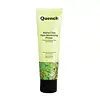What's inside
What's inside
 Key Ingredients
Key Ingredients

No key ingredients
 Benefits
Benefits

No benefits
 Concerns
Concerns

 Ingredients Side-by-side
Ingredients Side-by-side

Water
Skin ConditioningMethyl Methacrylate Crosspolymer
Butylene Glycol
HumectantPolymethylsilsesquioxane
Pentylene Glycol
Skin ConditioningSodium Acrylates Crosspolymer-2
Absorbent1,2-Hexanediol
Skin ConditioningAmmonium Acryloyldimethyltaurate/Vp Copolymer
Ethylhexylglycerin
Skin ConditioningHydroxyethyl Acrylate/Sodium Acryloyldimethyl Taurate Copolymer
Emulsion StabilisingSqualane
EmollientMelaleuca Alternifolia Leaf Oil
AntioxidantPolysorbate 60
EmulsifyingSorbitan Isostearate
EmulsifyingNymphaea Caerulea Flower Water
Skin ConditioningTocopherol
AntioxidantGlycerin
HumectantSalix Alba Bark Extract
AstringentEthyl Hexanediol
SolventCentella Asiatica Extract
CleansingHamamelis Virginiana Extract
AntiseborrhoeicPanax Ginseng Root Extract
EmollientWater, Methyl Methacrylate Crosspolymer, Butylene Glycol, Polymethylsilsesquioxane, Pentylene Glycol, Sodium Acrylates Crosspolymer-2, 1,2-Hexanediol, Ammonium Acryloyldimethyltaurate/Vp Copolymer, Ethylhexylglycerin, Hydroxyethyl Acrylate/Sodium Acryloyldimethyl Taurate Copolymer, Squalane, Melaleuca Alternifolia Leaf Oil, Polysorbate 60, Sorbitan Isostearate, Nymphaea Caerulea Flower Water, Tocopherol, Glycerin, Salix Alba Bark Extract, Ethyl Hexanediol, Centella Asiatica Extract, Hamamelis Virginiana Extract, Panax Ginseng Root Extract
Water
Skin ConditioningMethylpropanediol
SolventMethyl Methacrylate Crosspolymer
Polymethylsilsesquioxane
Pentylene Glycol
Skin ConditioningSodium Acrylates Crosspolymer-2
AbsorbentCaprylyl Glycol
EmollientGlyceryl Caprylate
EmollientAmmonium Acryloyldimethyltaurate/Vp Copolymer
Sodium Acrylate/Sodium Acryloyldimethyl Taurate Copolymer
Emulsion StabilisingPolyisobutene
Xanthan Gum
EmulsifyingSorbitan Oleate
EmulsifyingCaprylyl Glucoside
CleansingWater, Methylpropanediol, Methyl Methacrylate Crosspolymer, Polymethylsilsesquioxane, Pentylene Glycol, Sodium Acrylates Crosspolymer-2, Caprylyl Glycol, Glyceryl Caprylate, Ammonium Acryloyldimethyltaurate/Vp Copolymer, Sodium Acrylate/Sodium Acryloyldimethyl Taurate Copolymer, Polyisobutene, Xanthan Gum, Sorbitan Oleate, Caprylyl Glucoside
Ingredients Explained
These ingredients are found in both products.
Ingredients higher up in an ingredient list are typically present in a larger amount.
Ammonium Acryloyldimethyltaurate/Vp Copolymer (let's call it AAVC for short) is a synthetically created polymer. It's used as a film-forming agent and used to thicken the consistency of products.
AAVC is able to increase the consistency and viscosity of products due to its large molecule size. It also prevents ingredients from separating.
This ingredient comes as a powder made up of small, porous, microbeads. It is used to add a silky feel to products and also helps absorb oil.
Pentylene glycol is typically used within a product to thicken it. It also adds a smooth, soft, and moisturizing feel to the product. It is naturally found in plants such as sugar beets.
The hydrophilic trait of Pentylene Glycol makes it a humectant. As a humectant, Pentylene Glycol helps draw moisture from the air to your skin. This can help keep your skin hydrated.
This property also makes Pentylene Glycol a great texture enhancer. It can also help thicken or stabilize a product.
Pentylene Glycol also acts as a mild preservative and helps to keep a product microbe-free.
Some people may experience mild eye and skin irritation from Pentylene Glycol. We always recommend speaking with a professional about using this ingredient in your routine.
Pentylene Glycol has a low molecular weight and is part of the 1,2-glycol family.
Learn more about Pentylene GlycolPolymethylsilsesquioxane is a silicone used as a film forming agent.
When applied to the skin, this ingredient creates an invisible film on the surface. This film still allows oxygen to pass through, but prevents moisture from escaping. This can help condition and hydrate the skin. It also leaves a silky feel when applied.
Polymethylsilsesquioxane has not been shown to clog pores. It has been deemed safe to use up to 55%, but most cosmetics use much less.
If you have concerns about using this ingredient, we recommend speaking with a professional.
Learn more about PolymethylsilsesquioxaneWe don't have a description for Sodium Acrylates Crosspolymer-2 yet.
Water. It's the most common cosmetic ingredient of all. You'll usually see it at the top of ingredient lists, meaning that it makes up the largest part of the product.
So why is it so popular? Water most often acts as a solvent - this means that it helps dissolve other ingredients into the formulation.
You'll also recognize water as that liquid we all need to stay alive. If you see this, drink a glass of water. Stay hydrated!
Learn more about Water